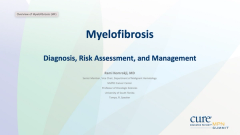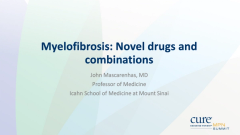
Educated Patient® MPN Summit Novel Drugs And Combinations for MF Presentation: May 20, 2023
Watch Dr. John O. Mascarenhas, from Icahn School of Medicine, discuss novel therapies in myelofibrosis during the CURE® Educated Patient® MPN Summit.
Episodes in this series

Although JAK2 inhibitors are a mainstay of therapy for patients with myelofibrosis, novel drug combinations and monotherapies are currently being studied in clinical trials that potentially represent additional treatment options, an expert said.
Dr. John O. Mascarenhas, professor of medicine at Icahn School of Medicine at Mount Sinai in New York, spoke about novel drug combinations for the treatment of myelofibrosis at the CURE® Educated Patient® MPN Summit.
“It is an exciting time to be involved in this field from a physician and physician researcher perspective,” he said during his presentation. “We have a lot more to offer patients and that's obviously very rewarding. I think the science is driving that development and that's really rewarding. That's the way it should be. And for patients, it gives them more opportunities for different therapies, and that's always a good thing to have.”
Paradigm Shift in Treatment Approaches
Mascarenhas noted that he believes the future focus of myelofibrosis treatment is moving beyond spleen and symptom benefit, but that is not to say that these two factors are not important.
“The future is focused on deeper responses, progression-free survival (the time during and after treatment when a patient with cancer lives with the disease without worsening), overall survival (the time when a patient with cancer is still alive), and greater disease course modification (a treatment that slows or delays disease progression by aiming at its primary cause),” he added.
In particular, cancer teams are focusing more on using JAK inhibitor-based combinations up front rather than “waiting for patients to get really ill from their disease and then trying to salvage the response,” Mascarenhas said.
One example of this approach is Jakafi (ruxolitinib) plus pelabresib, which was studied in a trial Mascarenhas and his team worked on called the MANIFEST trial. Findings from that trial demonstrated greater spleen and symptom benefit, in addition to reductions in bone marrow fibrosis and anemia responses in a proportion of patients.
In fact, Mascarenhas and his team are taking this research a step forward and are currently conducting the phase 3 MANIFEST-2 trial, of which preliminary data may be available later this year.
“I’m really excited about that (trial), and hopefully that’s a positive study,” Mascarenhas said. “I do think that, that will be really the first shift away from monotherapy and even (a) shift away from delayed combination therapy, the idea of waiting to add something if you don’t have an optimal response.”
Mascarenhas added that he believes that using combination therapies earlier in the disease may lead to deeper responses and may result in a longer duration of benefit, in addition to progression-free survival and overall survival.
Though side effects from combination therapies are expected and “maybe even accepted,” Mascarenhas said, the drugs that are in these combinations — Jakafi and pelabresib, among others — are pretty well tolerated. Some side effects that may be manageable include thrombocytopenia and low-grade gastrointestinal toxicity.
“In general, it seems to be a pretty well tolerated drug, and right now, it looks like you get additive efficacy with the two drugs together,” he said. “You get additive toxicity with the two drugs, (but) they seem to be pretty well tolerated as combinations.”
Navigating a New Treatment Space for Myelofibrosis
Even with the excitement of having many drugs in development to benefit patients with myelofibrosis, the availability of several treatment options may create questions and uncertainty for cancer teams, Mascarenhas said. This may be due to a lack of an algorithm or strategy to determine what treatment approach is best for a given patient.
He hopes that results from phase 3 studies will help cancer teams navigate the FDA-approved drugs like which sequence to administer them in.
“But we haven't yet gotten to the point where we can say, well, this is a molecular profile where you should go on this drug and some molecular power should go on that drug. That would really be interesting and important to do once we have all these data sets available,” Mascarenhas said.
Despite this, he said that the availability of these drugs is good progress.
“Previously, we just had one drug — Jakafi — forever. We didn't really have other options,” Mascarenhas explained. “And that was limiting our ability to treat the spectrum of patients. Now we have pacritinib (Vonjo) to treat patients with lower platelets. We have fedratinib (Inrebic), which is a great drug that we can use to salvage spleen responses in the second-line setting. We will likely have momelotinib approved in June, so that will also add to the armamentarium.”
For more news on cancer updates, research and education, don’t forget to











